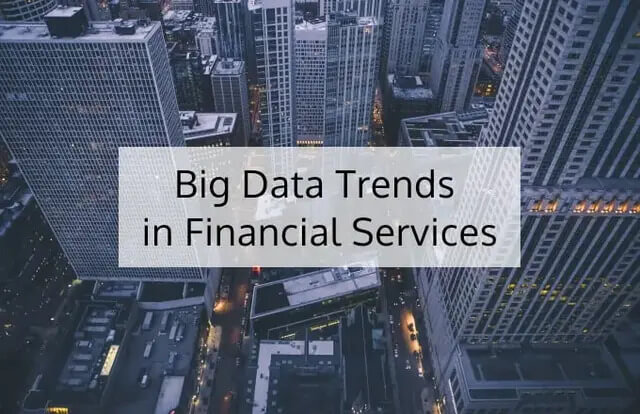

The term “Big Data” has begun taking over as the newest buzzword in the finance industry. But what does it really mean?

For demanding clients
Enterprise application
development
Mobile apps
Big Data and Data
Analytics
Tech recruitment
services
The ultimate business goal in regards to Big Data in the financial services industry is to gain real-time insight from the data to improve the overall business outcome. There are many different data-driven analysis methods that can be performed on financial datasets in order to optimize business growth, e.g. real-time analytics, customer analytics, and predictive analytics.
Simply put, analytics is the visible aspect of Big Data. If you want to take full advantage of the potential growth that Big Data has to offer your company, however, you’ll need to dive deeper.
In this article, we will cover some of the top Big Data trends to look out for in the financial services industry in 2024 so you can keep your company up-to-date in the digital world.
Financial services and institutions aren’t new to the digital landscape even if they went through a lengthy conversion process which required significant behavioral and technological change. Big Data in finance has contributed to major technical advances in recent years which have allowed the industry to come up with tailored, simple, and secure data-driven solutions. Big Data analytics has thus succeeded in transforming not only individual business operations but also the finance sector as a whole.
Data science resulted in a huge change in the finance industry – Machine Learning algorithms (among others) are now used to predict stock prices and improve risk assessment when granting loans.
The volume of data refers to the size of the data sets that need to be processes and analyzed. The volume of the data requires different, distinct processing technologies compared to traditional storage and processing capabilities. In other words, this means that data sets in Big Data are too large to process with a regular laptop or desktop processor. Volume is now expressed in zettabytes (ZB) or also yottabytes (YB). The Internet of Things ( IoT) is generating explosive data development.
Velocity is the speed at which data can be processed and evaluated. It is estimated that there are more than 18,9 billion network connections, with about 2.5 links per person on Earth.
Variety illustrates one of Big Data’s greatest obstacles. It can be unstructured and contain so many different data types. It’s no easy task to organize the data in a meaningful way, particularly when the data itself is evolving so rapidly.
Value is the end game. You want to be sure that your organization gets value from the data after addressing volume, velocity, variety, which requires significant time, effort, and resources.
Financial services companies want to do more than just store their data, they want to use it. Since this data comes from so many different sources, this poses a serious challenge when it comes to data management. Information processing systems ensure the integrity, reliability, and security of these data records.
At the same time, real-time analytics tools enable exposure, precision, and speed in regards to Big Data to help companies extract real-time quality insights and enable them to introduce new goods, services, and capabilities.
Many businesses today face strict regulatory requirements such as the Trading Book’s Fundamental Review (FRTB) which govern access to critical data and accelerated reporting requirements.
Some Big Data technology allows financial services institutions to cost-effectively scale up risk management, while improved metrics and reporting help transform data for analytical processing to provide the insights required for risk management.
Financial data comes from a variety of sources including employee documents, emails, business applications, and more. The combination and reconciliation of Big Data requires data integration tools that simplify both the storage and access processes.
Big Data technologies and the cloud operate in tandem to overcome these challenging business problems. As more financial service institutions adopt cloud solutions, they will become a stronger indication to the financial market that Big Data solutions are not only beneficial in IT use cases but also for business applications.
Is Big Data used in cybersecurity? Of course it is! Hadoop, Spark, Casandra are just a couple of examples of Big Data technologies used in this industry.
In September 2017, Equifax reported a data breach that revealed the personal information of over half of the American population. In one of the largest Big Data scares of the 21st century, 147 million people had their identities and extremely personal information exposed. Since then, cybersecurity has become one of the main Big Data priorities in the financial services industry.
Versive is a company that created software that they claim can help financial services institutions and banks analyze massive transaction datasets and cybersecurity data using Machine Learning.
The software is called Versive Security Engine and is touted as being able to integrate easily with cloud, hybrid, or on-premises data structures. This software uses Machine Learning algorithms to find patterns and abnormalities in the data networks that could indicate potential cyber threats.
Versive claims they have helped Riaz Invest Limited improve security within customer data. They claim the Versive Security Engine was able to reduce the number of false positives in threat identification at Riaz.

Do you have IT recruitment needs?
Robots aren’t just replacing truck drivers. They’re making their way into the financial services sector.
Robo-advisors are being deployed to offer low-cost, real-time, personalized financial portfolio advice to customers. Big Data analytics is now being used to passively manage portfolios without human intervention, strictly based on algorithms.
The first real robo-advisor, called Betterment, was launched in 2008. It offered investors access to asset rebalancing within target-date funds to manage passive investments. Even though human advisors already had this type of software, it was the first time investors could use it themselves without having to go through a human advisor.
It is predicted that by 2025 robo-advisors will act as digital platforms providing automated, algorithm-led financial planning services without the need for human advisors. Such robo-advisors will first collect client data about their financial overview as well as their goals through surveys and then use this data to automatically invest in assets and offer financial advice.
Simplistic versions of robo-advisors come in the form of chatbots, which can address simple customer inquiries, walk customers through the sales cycle, and offer tips and advice, all while gathering customer data to help improve the overall customer experience.
According to Barron’s, digital investment advice is poised to reach $1.26 trillion by 2023 as more everyday investors seek out low-fee robo-advisors.
Having lots of friends on Facebook or Instagram followers signifies popularity in certain social circles. Nowadays, your Facebook friends list may also impact your creditworthiness.
Neo Finance, Lend, and LendUp are just a few of the growing number of credit businesses using personal data mined from social networks like Facebook, Twitter, and LinkedIn to analyze a consumer’s credit risk, according to an article in The Wall Street Journal. These companies believe a person’s social life, professional connections, and digital reputation should be considered as important factors when extending credit.
These startups aim to take advantage of a perceived downside to traditional loan criteria, which are strictly based on FICO credit scores. While many people who lack borrowing experience or have missed payments would be disregarded by traditional criteria, LendUp’s goal is to reconsider loan extensions by looking at people’s social status.
For instance, perhaps recent immigration to the U.S. or a major medical emergency is dampening somebody’s credit score, while at the same time strong, active social ties and community connections may be a perceived indication of low risk. On the other hand, LendUp might find out that someone changed their phone number a lot, which may be an alternate indication of risk.
As Big Data becomes more widespread in the financial services industry, mortgage lending will also face many changes in 2025. Between 2014 and 2017, mortgage industry spending on Big Data increased from $2.6 billion to $3.2 billion according to Soma Metrics.
Similar to consumer social credit scores, mortgage applications are going to go beyond traditional data analysis methods and will begin incorporating social media data as well. Big Data will also be utilized in the application process to mine important inputs from public databases, bank records, and other websites in order to gather as much information on applicants as possible.
Another approach for the mortgage application process is to have homeowners finish their applications as usual and then use the mortgage company’s pre-populated data to identify any discrepancies between the applications. This will ensure even greater accuracy and reduce the application process time for applicants. Additionally, it will also help determine the risk of identity theft. If there are too many discrepancies, applications could be flagged for further manual reviews with applicants.
Computer programs will also score applications using Machine Learning algorithms. Just as job applications and resumes are now commonly being screened by Artificial Intelligence, mortgage lenders can use application scoring to their advantage.
Based on the algorithms set up, applicants can be approved or denied immediately. Approved applications may be processed right away, while rejected applications may either be discarded or qualified for manual review. This will save mortgage lenders both time and money since human review will not be needed until applications have passed the initial screening. It will also reduce delays in the process, allowing for mortgage lenders to scale more easily and, as a result, reach more clients.
Big Data analysis is also being used to price properties with greater accuracy. JPMorgan Chase is already using Big Data to accurately determine residential and commercial property sales prices for properties that have been repossessed due to defaulted mortgages.
Thanks to combining data on local property markets, economic conditions, and information extracted by algorithms we will be able to recommend reasonable sales prices before any mortgage loans begin defaulting. With more accurate pricing, any local property market shakeups from repossessions or defaults should be reduced. Also, there should be a reduction in the time period that a bank is forced to hold a property before making a new sale.
As Big Data becomes more advanced it can also be used to optimize protection and mitigate risk.
Liability analysis functions can provide earlier warning signs of potential risk exposures. Financial services institutions can be proactive in working with customers to limit liability and exposure to provide greater protection. Advanced customer data, transaction data, and geospatial data combined with advanced data analysis that looks at transaction anomalies will allow for easier risk detection and fraud prevention.
Ayasdi, an artificial intelligence software company, uses Big Data analytics through Ayasdi’s Model Accelerator (AMA), to help financial services companies model and predict regulatory risk with Machine Learning. They claim their software is able to help banks with regulatory compliance in anti-money laundering, which can automatically scan customer transaction data to reduce false positives and spot any anomalies in fraud detection.
Financial services institutions and banks can easily integrate the software into their own enterprise data networks. The software’s algorithm will sift through customer data and sales transactions to compare and test real-time risk-models, including the probability of default, loss-given default, and other models. These data insights can be easily viewed in a simple dashboard to discover current real-time risks and predict potential risks.
In the past, large financial services organizations with multiple departments (retail banking, commercial banking, asset management, etc.) had to set up individual Big Data analytics platforms. This made data mining and data transfer between the different business sectors extremely time-consuming and inefficient.
In 2024, however, unified data analytics platforms will make it possible for large financial institutions to benefit from an easy-to-use data analysis system.
A big European financial group serving 40 million clients recently hired DevsData & GetInData, a world-class team of software and data engineers, to build a unified solution for data processing across departments in 2019.
The client has been a leader in the financial services sector due to its advanced data processing and analytics. Like most financial services companies that have various business departments, however, it’s complicated to try to communicate different data points between various business units, as each uses a different analytics platform. With retail banking, commercial banking, direct banking, investment banking, asset management, and insurance services, there is a vast amount of data that has to be mined through different platforms.
The unified analytics platform will allow for customized data science environments to be created on-demand. Data scientists will be able to use their own personalized, dedicated, data-driven work conditions using a simple user interface to create and deploy Machine Learning easily throughout the entire organization.
The platform will also make data management easier and ensure higher data quality. Data quality checks will be automatically implemented in Spark, resulting in less ingestion to increase the speed of the system. On top of that, Apache Atlas will be used as the core component for data governance actions including data discovery, data tagging, and business glossary.
The company is in the process of creating the next-generation, cloud-ready, unified Big Data analytics platform that will be based on an open-source stack. It will be one of the most advanced tech endeavors across all business departments whose primary industry isn’t technology.

Leveraging Big Data solutions such as Hadoop clusters can certainly pay off for each and every company that possesses massive amounts of data.
Of course, it requires some careful attention, but also comes with the advantage of having all of the data in one place. Unfortunately, it’s likely that one day you will reach the upper limits of performance – the moment when you cannot add more processing due to hardware limitations. What can possibly be done in this instance? The best solution is to consider the hybrid cloud.
A hybrid cloud is an approach where a company can extend its internal capabilities with on-demand cloud infrastructure. This is a great Big Data solution for companies that wish to quickly scale up business and analyze all the data inputs much more quickly. What is most significant about this solution is that a hybrid cloud is fully configurable and the data is stored safely inside it.
Big Data has rapidly made its way into the financial services industry as playing one of the most important roles in business optimization. As it turns out, however, the industry has been lagging behind big time, especially when being compared to other industries like media or telecom.
Morgan Stanley’s Digitalization Index compares the top 34 sectors in terms of digital maturity, analyzing how far various sectors have developed within the digitalization path. Out of 34 sectors, you would imagine that financial services would be one of the top industries, and yet it ranked only at number 18, behind Utilities, Pharma, and Oil & Gas.
The financial services industry faces ever-increasing competition in a new era of Big Data. Personalizing the customer experience through robo-advisory, increasing cybersecurity to mitigate data breaches, and looking beyond credit scores into social scores are all at the forefront of Big Data changes in the financial sector.
Leading your organization to compete in this new Wild West of Big Data is essential if you want to stay ahead of the pack.
If you want to take advantage of Big Data in 2024, but you aren’t sure where to start, you can reach out to us.
DevsData is a technology consulting company and software agency based in New York City and Europe. We are experts in the field of Big Data in financial services. Our team is equipped with top-tier engineers, and we have the skills, experience, and resources to build complex, personalized Big Data systems to grow your financial business.
Whether you need Big Data advisory with tech consulting or a custom-tailored system overhaul to optimize growth, we’re here to help.
Frequently asked questions (FAQ)
DevsData – a premium technology partner
DevsData is a boutique tech recruitment and software agency. Develop your software project with veteran engineers or scale up an in-house tech team with developers with relevant industry experience.
Free consultation with a software expert
🎧 Schedule a meeting
“DevsData LLC is truly exceptional – their backend developers are some of the best I’ve ever worked with.”
Nicholas Johnson
MENTOR AT YC,
SERIAL ENTREPRENEUR
Categories: Big data, data analytics and AI | Software and technology | IT recruitment blog | IT in Poland | Content hub (blog)


 Our veteran developers can help you build your project.
Our veteran developers can help you build your project.
 Explore the benefits of technology recruitment and tailor-made software.
Explore the benefits of technology recruitment and tailor-made software.
 Learn how to source skilled and experienced software developers.
Learn how to source skilled and experienced software developers.
“I interviewed about a dozen different firms. DevsData LLC is truly exceptional – their backend developers are some of the best I’ve ever worked with. I’ve worked with a lot of very well-qualified developers, locally in San Francisco, and remotely, so that is not a compliment I offer lightly. I appreciate their depth of knowledge and their ability to get things done quickly. “

Nicholas Johnson
CEO OF ORANGE CHARGER LLC;
MENTOR AT YCOMBINATOR




